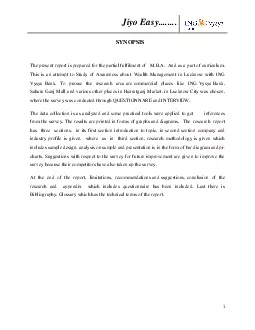PDF-The present report is prepared for the partial fulfilment of MBA An
Author : hazel | Published Date : 2021-09-13
Jiyo Easy1SYNOPSISpart of curriculumThis is an attempt to Study of Awareness aboutWealth Managementin Lucknow with ING Vysya Bank To pursue the research area are
Presentation Embed Code
Download Presentation
Download Presentation The PPT/PDF document "The present report is prepared for the p..." is the property of its rightful owner. Permission is granted to download and print the materials on this website for personal, non-commercial use only, and to display it on your personal computer provided you do not modify the materials and that you retain all copyright notices contained in the materials. By downloading content from our website, you accept the terms of this agreement.
The present report is prepared for the partial fulfilment of MBA An: Transcript
Download Rules Of Document
"The present report is prepared for the partial fulfilment of MBA An"The content belongs to its owner. You may download and print it for personal use, without modification, and keep all copyright notices. By downloading, you agree to these terms.
Related Documents














